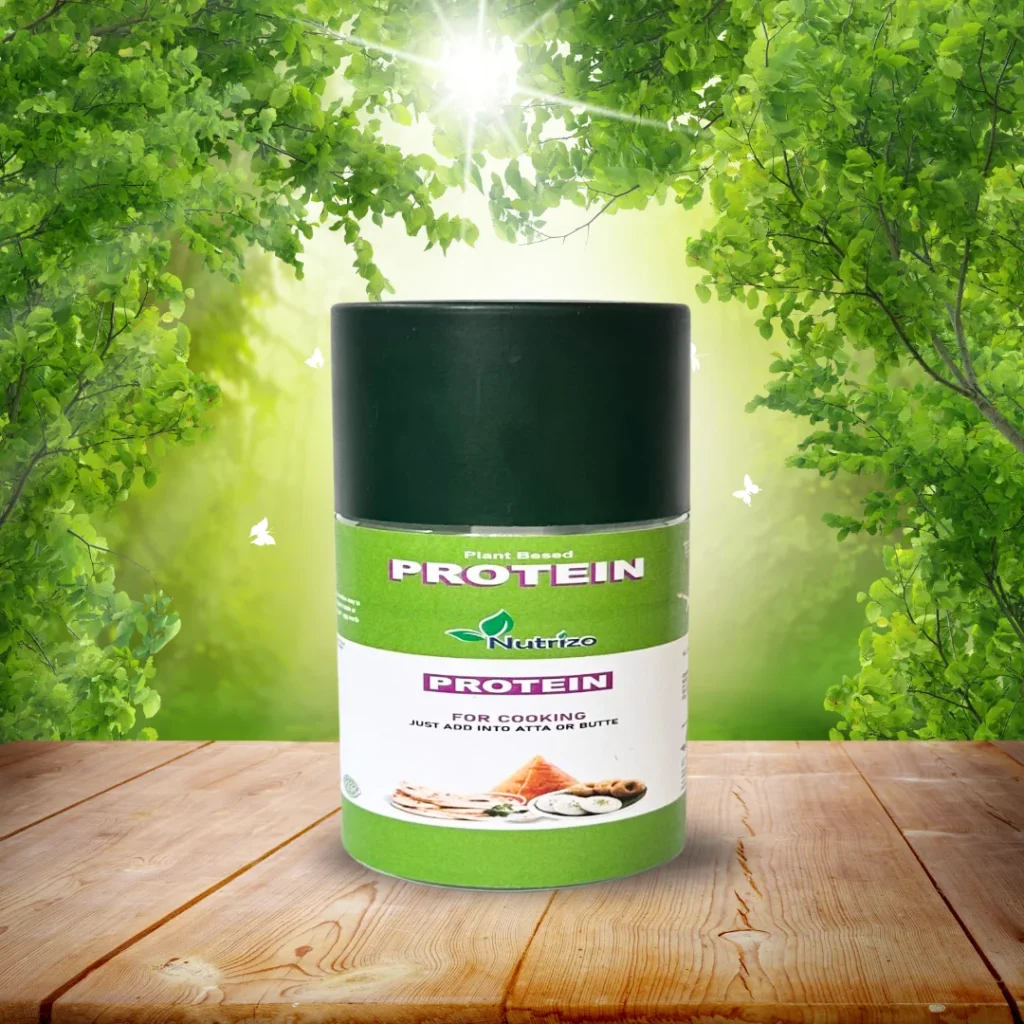
Plant-based protein has surged in popularity as an increasingly recognized and embraced dietary option, offering a plethora of benefits for both individuals and the planet. Derived from sources such as legumes, nuts, seeds, and grains, plant-based protein provides a diverse array of nutrients while promoting sustainable food production practices. Unlike animal-based protein sources, plant-based alternatives often contain higher fiber content, essential vitamins, and minerals, all contributing to improved digestion and overall health
Pea protein
Pea protein, derived from yellow peas, stands out as a powerhouse among plant-based proteins. Packed with essential nutrients like protein, iron, and branched-chain amino acids, it offers a comprehensive nutritional boost.
Nutritional Profile: Pea protein boasts an impressive protein content of approximately 25-30 grams per 100-gram serving in concentrated form. Packed with essential amino acids, especially branched-chain amino acids (BCAAs) like leucine, isoleucine, and valine, it provides comprehensive nutritional support. With low fat and carbohydrate content, it caters to various dietary preferences and goals.
Versatility: Available in diverse forms including powders, bars, and shakes, pea protein seamlessly integrates into a multitude of recipes. Whether as a standalone supplement or a key ingredient in smoothies, baked goods, or savory dishes, it enhances protein content and texture with ease.
Allergen Friendly: Naturally devoid of common allergens like gluten, dairy, soy, and nuts, pea protein suits individuals with food sensitivities or allergies. Its hypoallergenic nature and excellent digestibility make it a reliable choice for most people.
Sustainability: Pea protein emerges as an environmentally conscious option compared to animal-derived proteins, with a significantly lower carbon footprint and water usage. Peas, as nitrogen-fixing legumes, demand less water and land, aligning with sustainable protein production practices.
Health Benefits: Beyond protein, pea protein offers substantial fiber content, aiding in satiety, blood sugar regulation, and digestive health. Its minimal allergens and antinutritional factors make it gentle on the digestive system, supporting overall well-being.
Muscle Building: Particularly beneficial for athletes and fitness enthusiasts, pea protein’s abundance of BCAAs, notably leucine, fuels muscle protein synthesis and post-exercise recovery, facilitating muscle growth and maintenance.
Cooking Tips: Utilizing pea protein powder involves following manufacturer guidelines for optimal usage. Whether blended into beverages or incorporated into baked treats like pancakes or muffins, it adds a nutritious punch to culinary creations.
Chik Pea Protein
Chickpea plant protein, derived from the versatile legume known as chickpeas or garbanzo beans, holds a rich history of culinary tradition and nutritional excellence:
Nutritional Profile: Renowned for their protein content, cooked chickpeas offer approximately 19 grams of protein per 100 grams serving, alongside substantial dietary fiber, essential vitamins, and minerals such as folate, iron, phosphorus, and manganese.
Versatility: Chickpea protein presents itself in various forms, from whole chickpeas to chickpea flour and protein powder. Whole chickpeas lend themselves to diverse dishes like salads, soups, and curries, while chickpea flour finds its place in staple recipes such as falafel, hummus, and savory pancakes. Chickpea protein powder serves as a convenient addition to smoothies, baked goods, and savory creations, augmenting both nutrition and taste.
Allergen Friendly: Naturally devoid of common allergens like gluten, dairy, soy, and nuts, chickpea protein accommodates individuals with dietary sensitivities or allergies, offering a safe and nutritious alternative.
Sustainability: With a comparably lower carbon footprint and water usage than animal-based proteins, chickpeas emerge as an environmentally sound choice. Their efficient resource utilization underscores their eco-friendly profile, contributing to sustainable food systems.
Health Benefits: Incorporating chickpea protein into a balanced diet yields manifold health advantages, including enhanced heart health, blood sugar regulation, digestion, and weight management. The amalgamation of fiber and protein promotes satiety, aiding in appetite control and blood sugar stability.
Cooking Tips: Maximizing the flavor and digestibility of chickpea protein involves careful preparation and seasoning. Soaking dried chickpeas prior to cooking reduces cooking time and enhances texture, while the addition of spices, herbs, and aromatics elevates the taste profile of chickpea-centric dishes.
Chickpea plant protein stands as a nutritional powerhouse and culinary chameleon, offering a spectrum of health benefits and culinary possibilities. Its adaptable nature makes it an invaluable ingredient for boosting protein intake and enriching meals with both flavor and substance.
Brown rice protein
Brown rice protein, extracted from whole grain brown rice with its bran layer intact, offers a nutritious and versatile option for plant-based diets:
Nutritional Profile: Packed with approximately 7-8 grams of protein per 25-gram serving, brown rice protein serves as a high-quality plant-based protein source. It is also brimming with essential amino acids, fiber, and an array of vitamins and minerals, including B vitamins, magnesium, and phosphorus. Despite its slightly lower protein content compared to other plant-based sources like soy or pea protein, it remains a valuable addition to a balanced diet.
Versatility: Available in multiple forms such as protein powders, bars, and ready-to-drink shakes, brown rice protein seamlessly integrates into various recipes. Whether incorporated as a standalone supplement or blended into smoothies, oatmeal, or baked goods, it effortlessly boosts protein content without compromising taste.
Allergen Friendly: Naturally free from common allergens like gluten, dairy, soy, and nuts, brown rice protein caters to individuals with dietary sensitivities or allergies, offering a safe and nourishing option.
Digestibility: Generally well-tolerated and easy on the digestive system, brown rice protein is a preferred choice for most people. However, excessive consumption may lead to mild digestive discomfort, which can be mitigated by opting for high-quality products and ensuring adequate hydration.
Sustainability: With a significantly lower carbon footprint and water usage compared to animal-derived proteins, brown rice protein aligns with sustainable food choices. Its cultivation requires minimal resources, making it an eco-friendly option for protein production.
Health Benefits: Low in fat and cholesterol, brown rice protein supports heart health and provides antioxidants and phytonutrients that contribute to overall well-being. Its fiber content aids in digestion and helps regulate blood sugar levels.
Cooking Tips: Adhering to manufacturer guidelines ensures optimal usage. Brown rice protein powder blends effortlessly with liquids to create shakes or smoothies, and adds nutritional value to baked goods like pancakes, muffins, and bars.
In summary, brown rice plant-based protein offers a nutritious and adaptable ingredient that facilitates protein intake and promotes a healthy lifestyle.
Green Gram Protein
Green gram, also known as mung bean or moong bean, stands out as a beloved legume celebrated for its diverse culinary applications and nutritional richness:
Nutritional Profile: Bursting with approximately 24 grams of protein per 100 grams serving when cooked, green gram emerges as a robust plant-based protein source. Additionally, it boasts a wealth of dietary fiber, vitamins such as folate, vitamin B6, and vitamin C, and essential minerals like iron, magnesium, and potassium.
Versatility: Green gram lends itself to various forms, including whole green gram, split green gram (moong dal), and green gram flour. Sprouted whole green gram adds a delightful crunch to salads, stir-fries, and soups, while split green gram takes center stage in delectable Indian dishes like dals, curries, dosa, and idli. Green gram flour transforms into versatile batters for pancakes, crepes, and a myriad of baked delights.
Digestibility: Renowned for its gentle digestibility, green gram caters to individuals with sensitive digestive systems. Sprouting enhances its digestibility and nutrient availability, further elevating its nutritional prowess.
Allergen Friendly: Similar to chickpea protein, green gram protein is naturally devoid of common allergens such as gluten, dairy, soy, and nuts, offering a safe and nourishing choice for those with dietary sensitivities.
Sustainability: With its nitrogen-fixing ability and modest water requirements, green gram cultivation champions environmental stewardship, minimizing the reliance on synthetic fertilizers and conserving water resources compared to other protein crops like soybeans.
Health Benefits: Low in fat and cholesterol yet rich in antioxidants, green gram promotes heart health and cellular protection against free radical damage. Its fiber content supports digestive health and aids in blood sugar regulation, contributing to overall well-being.
Cooking Tips: Prioritize thorough cleaning and rinsing of green gram to remove any impurities before cooking. Adjust cooking times based on whether using whole or split green gram. Elevate flavors by incorporating aromatic spices, fresh herbs, and complementary seasonings into green gram-based dishes.
Green gram plant-based protein shines as a versatile and nutritious ingredient, enriching meals with protein abundance and culinary delight.
Soya protein
Soy plant-based protein, derived from soybeans native to East Asia, stands as a nutritional powerhouse with versatile culinary applications:
Nutritional Profile: Soybeans are renowned for their impressive protein content, offering approximately 36 grams of protein per 100 grams serving when cooked. Additionally, they provide essential amino acids, fiber, and an array of vitamins (including folate, vitamin K, and vitamin C) and minerals (such as iron, calcium, and magnesium).
Versatility: Soy protein manifests in various forms, from tofu and tempeh to soy milk, yogurt, and protein powder. Tofu, known as bean curd, lends itself to savory and sweet dishes alike, thanks to its mild flavor and adaptable texture. Tempeh, a fermented soybean product, boasts a nutty flavor and firm consistency, making it ideal for grilling, stir-frying, and baking. Soy milk and yogurt serve as dairy-free alternatives, enriching beverages, smoothies, and desserts. Soy protein powder offers a convenient means to fortify shakes, smoothies, and baked goods with protein.
Complete Protein: As one of the few plant-based proteins deemed complete, soy protein contains all nine essential amino acids essential for bodily functions, making it a standout alternative to animal-derived proteins.
Health Benefits: Embracing soy plant-based protein in a balanced diet is linked with various health perks. Low in saturated fat and cholesterol, soy protein supports heart health. Its isoflavones, phytochemicals with antioxidant properties, may aid in reducing the risk of chronic diseases like heart disease, osteoporosis, and certain cancers.
Allergen and Gluten-Free: Naturally devoid of common allergens such as gluten, dairy, and nuts, soy protein caters to individuals with dietary sensitivities or allergies, offering a wholesome and inclusive option.
Sustainability: Soybeans boast an eco-friendly profile compared to animal-based proteins, boasting a lower carbon footprint and water usage. Their efficient resource utilization underscores their role in sustainable protein production.
Cooking Tips: Elevate soy protein’s taste and texture by experimenting with diverse cooking methods and flavorings. Marinating tofu or tempeh prior to cooking infuses depth of flavor and moisture, while spices, herbs, and sauces enhance culinary creations centered around soy protein.
Soy plant-based protein emerges as a nutritious and adaptable ingredient, empowering culinary exploration while promoting protein intake and overall well-being
Sesame Protein
Sesame plant-based protein, derived from sesame seeds, offers a unique blend of flavor and nutrition, enriching culinary experiences with its versatility:
Nutritional Profile: Sesame seeds are a treasure trove of nutrients, packing a punch with protein content averaging at around 17 grams per 100 grams serving. Alongside protein, they boast essential amino acids, healthy fats, dietary fiber, vitamins (such as vitamin E and B vitamins), and minerals (including calcium, iron, and magnesium).
Versatility: Sesame protein presents itself in various forms, from whole sesame seeds and sesame oil to tahini (sesame seed paste) and sesame protein powder. Whole sesame seeds add a delightful crunch and nutty flavor to salads, stir-fries, and baked goods. Tahini serves as a creamy base for dressings, dips, and sauces, infusing dishes with a rich and savory depth. Sesame protein powder offers a convenient means to fortify shakes, smoothies, and baked goods with protein.
Nutrient Density: Sesame protein showcases an impressive nutrient density, contributing to overall health and vitality. Rich in antioxidants like lignans and vitamin E, it supports cellular health and may aid in combating oxidative stress and inflammation.
Health Benefits: Incorporating sesame plant-based protein into a balanced diet may confer various health benefits. Its abundance of healthy fats, particularly monounsaturated and polyunsaturated fats, supports heart health and may help lower cholesterol levels. Additionally, sesame protein’s calcium content promotes bone health and may reduce the risk of osteoporosis.
Allergen Friendly: Sesame protein is naturally free from common allergens such as gluten, dairy, soy, and nuts, catering to individuals with dietary sensitivities or allergies, and providing a safe and nourishing option.
Sustainability: Sesame cultivation boasts environmental benefits, requiring relatively low water usage and thriving in diverse climates. Its resilience and efficient resource utilization contribute to sustainable protein production practices.
Cooking Tips: Elevate dishes with sesame protein by incorporating sesame seeds, tahini, or sesame oil into recipes. Sprinkle sesame seeds over salads, stir-fries, or baked goods for added texture and flavor. Harness the creaminess of tahini in dressings, dips, or marinades, and infuse dishes with the aromatic richness of sesame oil.
Sesame plant-based protein stands as a flavorful and nutrient-rich ingredient, offering culinary creativity while supporting protein intake and overall wellness.















